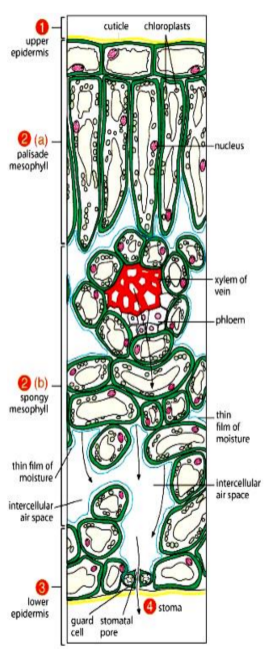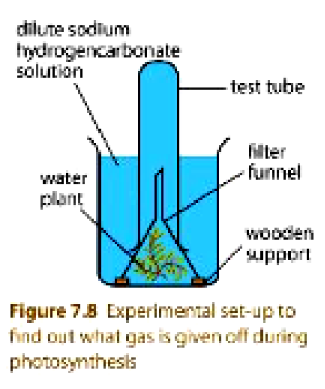Nutrition and Transport in Flowering Plants
1/18
There's no tags or description
Looks like no tags are added yet.
Name | Mastery | Learn | Test | Matching | Spaced |
|---|
No study sessions yet.
19 Terms

UPPER EPIDERMIS
Single layer of closely packed cells
Waxy cuticle
protects the enclosed leaf tissue
prevents excessive evaporation of water
is transparent and allows light to pass through for photosynthesis
PALISADE MESOPHYLL
Consists of closely packed long, cylindrical cells
Contains numerous chloroplasts that allow it to absorb MAXIMUM sunlight for photosynthesis
SPONGY MESOPHYLL
Irregularly shaped
Numerous intercellular air spaces to allow for diffusion of gases in the leaf
Contains chloroplasts but fewer than in palisade mesophyll
Contains the vascular bundle which contains the xylem and phloem
Xylem transports water and mineral salts from roots to the leaf (thick, lignified walls prevent the collapse of xylem vessels)
Phloem translocates sucrose and amino acids from the leaves to all parts of the plant
LOWER EPIDERMIS
Single layer of closely packed cells covered by an outer layer of cuticle
STOMA
Minute openings called stomata
Define photosynthesis
the process in which light energy absorbed by the chlorophyll is used to release chemical energy.
The chemical energy is used to synthesize carbohydrates from water and carbon dioxide.
Water and carbon dioxide are raw materials for the process.
Oxygen is released in the process.
Word equation:
carbon dioxide + water —light energy/chlorophyll→ glucose + oxygen + water
Chemical equation:
6CO2 + 6H2O —light energy/chlorophyll→ C6H12O6 + 6O2
Describe how CO2 reaches mesophyll cells in a leaf
CO2 in the leaf is rapidly used up in the day due to photosynthesis
CO2 concentration in the leaf is lower compared to the air, resulting in a concentration gradient
Thus, CO2 from the surrounding air diffuses into the air spaces within the leaf l through the stomata
A thin film of moisture covers the surface of the mesophyll cells, allowing CO2 to dissolve in it
The dissolved CO2 then enters the cell as a solution.
Factors affecting Photosynthesis
Light intensity
Carbon dioxide concentration
usually the limiting factor
Temperature
Photosynthesis is an enzyme-controlled reaction
Define and explain the term Transpiration
The loss of water vapour from the aerial parts of a plant, mainly through the stomata of the leaves
Cools the plant
Creates a transpiration pull
Affected by:
Wind
Temperature
Humidty
Light intensity
Explain the movement of water between plant cells, and between them and the environment in terms of water potential (calculations on water potential are not required)
Evaporation of thin film of moisture surrounding cell B produces water vapour, which is lost from the intercellular airspaces to the atmosphere through the stomata.
This reduces water potential of cell sap in B as it replaces the lost thin film of moisture.
Cell sap of A now has higher relative water potential than that of B
Water molecules move from cell sap of A into that of B through the partially permeable membrane via osmosis.
Outline the pathway by which water is transported into the roots and through the xylem vessels to the leaves by transpiration pull
Water enters the root hair via osmosis and dissolved mineral salts by active transport and diffusion.
Water flows from the root hair cells to the to the xylem via osmosis
Xylem conducts water and mineral salts up from the roots to the leaves
Water diffuses out of the leaves through the stomata via transpiration
Investigate and explain the effects of variation of air movement, temperature, humidity and light intensity on transpiration rate
How can we test for starch?
How can we find out whether sunlight is necessary for photosynthesis?
How can we find out whether chlorophyll is necessary for photosynthesis?
How can we find out whether CO2 is necessary for photosynthesis?
How can we find out what gas is given off during photosynthesis?
How can we test for STARCH?
Remove a green leaf from a plant that has been exposed to the sun for a few hours
Immediately put the leaf in boiling water for 2 minutes
Put the boiled leaf in a boiling tube containing some alcohol/ethanol. Place the boiling tube in a beaker of hot water
The leaf is now very brittle. Take the leaf out and place it back into the boiling water. This makes the leaf more permeable to the iodine solution.
Remove the leaf and spread it evenly on a white tile. Add a few drops of iodine solution to the leaf.
How can we test whether SUNLIGHT is needed for photosynthesis?
Destarch a potted plant by placing it in the dark for 2 days
Remove one leaf. Test it for starch*
Sandwich a leaf, which is still attached to the plant, between 2 pieces of black paper. Each paper has a certain pattern cut out from it. Fasten it with paperclips and place the plants in strong sunlight
After a few hours, remove the leaf and test it for starch
Make a drawing of the leaf to show which areas are stained with blue-black
How can we test whether CHLOROPHYLL is needed for photosynthesis?
Destarch a plant with variegated leaves
Expose the plant to strong sunlight for a few hours
Remove one of the leaves and make a drawing to show the distribution of green parts
Decolorize the leaf and test it for starch
Make a drawing of the leaf to show the distribution of the blue-black on the leaf. Compare this with the drawing in step 3.
How can we test whether CARBON DIOXIDE is needed for photosynthesis?
Destarch two potted plants by placing them in the dark for two days
Enclose the pots in polyethene bags and secure them to the stem
Place one pot in a bell jar containing a dish containing KOH and soda lime which rapidly absorb carbon dioxide.
Set up a control by placing the other pot in a bell jar using pebbles and water instead of soda lime and KOH respectively.
Leave both set ups in strong sunlight for a few hours
Remove a leaf from each set up and test them for starch
How can we find out what GAS is given off during photosynthesis?
Set up some freshwater plants as shown in the figure
Dissolve a little sodium hydrogencarbonate in the water in the beaker. This provides carbon dioxide to the plant
Place the set up in strong sunlight for a few hours
Gas bubbles form on the leaves in the beaker. The bubbles then rise up the test tube and displace the water downwards. When the test tube is half filled with gas, remove the test tube by placing a thumb over its mouth
Test the gas with a glowing splinter

Translocation
the transport of manufactured food substance, such as sugars and amino acids, in plants
The “Ringing experiment”.
Create a ring of bark with the phloem removed
Swelling is observed. This is because food substances accumulate at that area, causing it to swell.